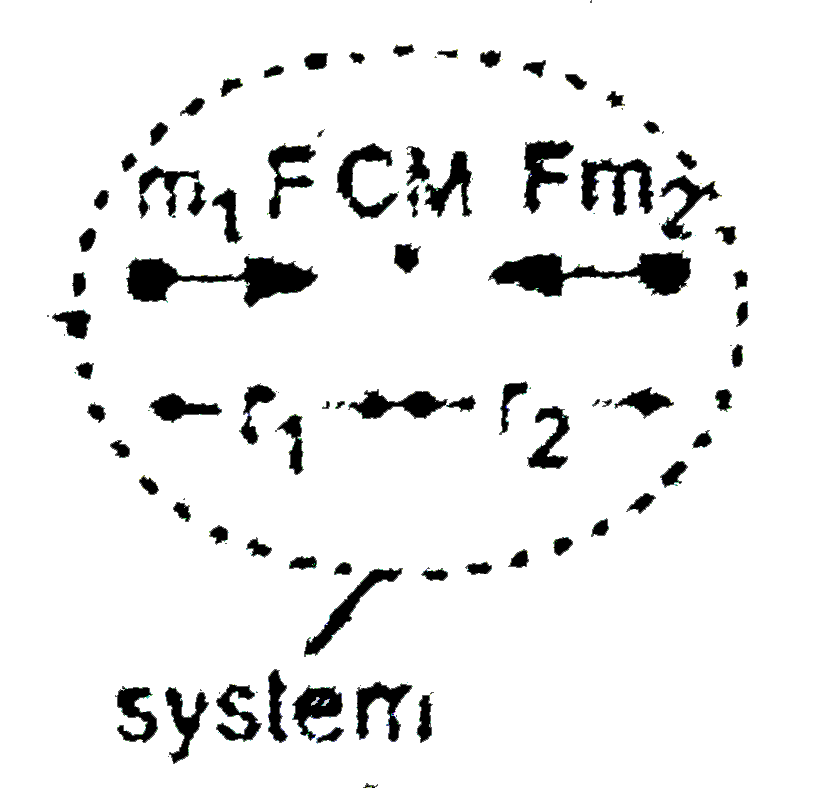Two particles of masses and are placed at separation on a smooth surface. They move towards each other due to mutual attractive force. Find (a) acceleration of c.m. (b) Velocity of c.m. when separation between particles becomes . ( c) At what distance from the initial position of mass , the particles collide.
(a) In a absence of any external force the acceleration of CM is zero.
,
(b) Initially the particles are at rest , therefore, . Since , the velocity of CM is constant and hence is always zero whenever the separation becomes etc.
(c) First, locate the CM
= 3d/53d//5 from A.

Topper's Solved these Questions
- CENTRE OF MASSBOOK - DC PANDEYCHAPTER - CENTRE OF MASSEXERCISE - Check points
50 Videos
- CENTRE OF MASSBOOK - DC PANDEYCHAPTER - CENTRE OF MASSEXERCISE - Taking it together
73 Videos
- CALORIMETRY AND HEAT TRANSFERBOOK - DC PANDEYCHAPTER - CALORIMETRY AND HEAT TRANSFEREXERCISE - Medical entrance s gallery
38 Videos
- CENTRE OF MASS, IMPULSE AND MOMENTUMBOOK - DC PANDEYCHAPTER - CENTRE OF MASS, IMPULSE AND MOMENTUMEXERCISE - Comprehension type questions
15 Videos
Similar Questions
Two particles of masses m and M are initially at rest at an infinite distance part. They move towards each other and gain speeds due to gravitational attracton. Find their speeds when the separation between the masses becomes equal to d.
View SolutionConsider a system of two particles of masses m1 and m2 separated by a distance r. Suppose they start to move towards each other due to their mutual attraction (attractive force may be electrical, gravitational, etc.).

View Solution
Knowledge Check
Two particles A and B of masses 2m and m are placed on a smooth surface at separation d. They move towards each other due to the mutual attractive force.
(i) The particles will meet at distance d/3 from the initial position of mass 2m.
(ii) The speed of A will be half of speed of B until the particles collide (excluding the initial speed).
(iii) The distance covered by B is always double that covered by A until the particles collide.
(iv) The velocity of center of mass is always zero.A(i),(ii)B(i),(ii),(iii)C(ii),(iii),(iv)Dall options are correctTwo particles of masses 4kg and 6kgareseparatedbyadistanceof20cm and are moving towards each other under mutual force of attraction, the position of the point where they meet is
A12mfrom 4kg bodyB12m from 6kg bodyC8m from 4kg bodyD10m from 4kg bodyIf two particles of masses 3kg and 6kg which are at rest are separated by a distance of 15m. The two particles are moving towards each other under a mutual force of attraction. Then the ratio of distances travelled by the particles before collision is
A2:1B1:2C1:3D3:1
Two particles A and B of masses 1 kg and 2 kg respectively are kept 1 m apart and are released to move under mutual attraction. Find The speed A when that of B is 3.6 cm/hr. What is the separation between the particles at this instant?
View SolutionTwo charged particles of masses m and 2m are placed distane d apart on a smooth horizontal table. Because of their mutual attraction, they move towards each other and collide. Where will the collision occure with respect to the initial positions?
View Solution10 Two particles of masses m1 and m2 initially at rest start moving towards each other under their mutual force of attraction. The speed of the centre of mass at any time t, when they are at a distance r apart, is
View SolutionTwo particles of mass m and M are initially at rest and infinitely separated from each other. Due to mutual interaction, they approach each other.
Their relative velocity of approach at a separation d between them, is
View SolutionIn free space, two particles of mass m each are initially both at rest at a distance a from each other. They start moving towards each other due to their mutual gravitational attraction. The time after which the distance between them has reduced to a2 is:
View Solution
